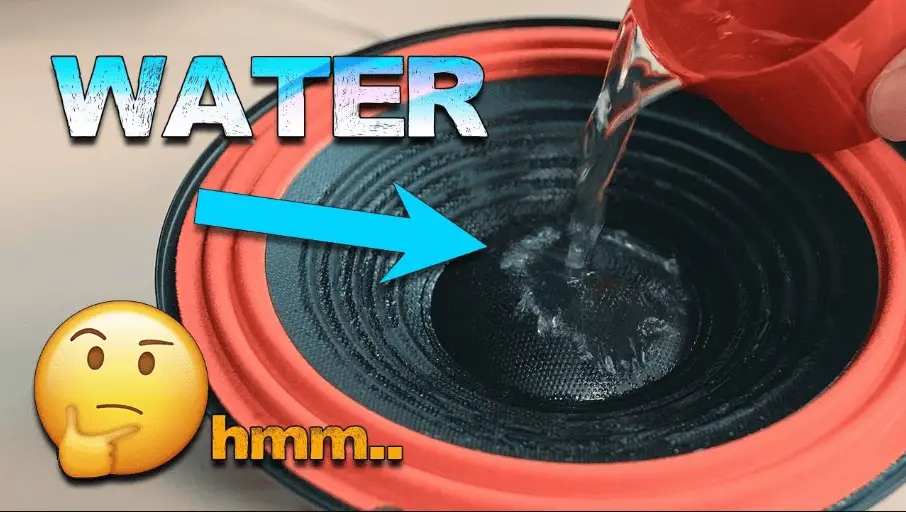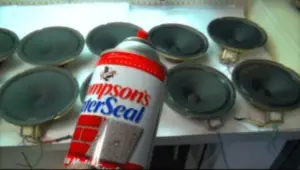Imagine you took your car to the car wash, and they got the subwoofer in your trunk wet by mistake, or maybe the subwoofer in your home audio system is near windows, and you forgot to close them when it was raining.
The question that comes to mind is, Will that be the end of your subwoofers? And, Is it possible for subwoofers to get wet without causing harm or problems?
Waterproofing subwoofers is a simple technique to ensure that your subwoofer is secured from any kind of harm caused by the water.
Unless you want to bury your subwoofers in water, you should create a waterproofing casing for them; there are some simple ways to waterproof your subwoofers.
Despite the skeptics, What’s the best way to make them waterproof? Don’t worry; I’ve got answers to all of your questions. Let’s get started without wasting any time.
How can I make my subwoofer waterproof?

Waterproofing your subwoofers may be done with reasonable ease and without a lot of financial stress.
Subwoofers are made from a variety of materials. Some of the Water-resistant materials used in their manufacturing include rubber, which is used to make cones and sometimes surrounds. Indoor subwoofers contain paper diaphragms in the drivers, which are sensitive to humidity.
So, in order to protect your subwoofers from humidity and getting wet, it is a good practice to make them waterproof.
To make your subwoofers waterproof, you can also use high gloss polymer and polyurethane spray; these both have proved to be very effective waterproof materials for electronic devices.
- A couple of layers of clear spray paint might be helpful in the waterproofing method. To waterproof tents, use a spray can sealer called “Camp Dry,” which is similar to Scotch guard.
- No more than a couple of layers of paint. You can also try spraying a leak stopper, which is also a rubber spray, on subs with little or no effects.
Furthermore, Coating your subwoofers in a high gloss polymer is the simplest and cheapest way to protect them.
The coating is usually a polymer varnish or a polyurethane spray, although the polyurethane spray is solely functional and has no visual appearance. High-gloss polymers are commonly used to restore and reinforce floors that get a lot of use on a regular basis.
People employ high gloss polymers to waterproof and enhance resistance for a variety of reasons: the chemical composition is often non-toxic, chemical resistant, and highly easy to apply.
Both of these techniques are proved to be highly effective for waterproofing electronic devices, including subwoofers.
A basic coating of a high gloss polymer will most probably be sufficient for making them waterproof, depending on the capacity of use for your subwoofers.
There are various low-cost products designed specifically for subwoofers, speakers, and electronics use.
Step by Step Guide to waterproof subwoofers
Follow these steps to waterproof your subwoofers.
Step 1
Make sure your workspace is ready. The application of the coating may sometimes be a mess, so make sure you’re in a well-ventilated place. Using newspaper to cover your workplace can help prevent your coating from overflowing onto other surfaces in your home or garage.
Step 2
Take off the grill that covers the speaker cone.
Note: If you did not purchase a subwoofer-specific sealant, it is recommended that you consult an audio expert to guarantee that the substance will not damage the subwoofer’s performance.
Step 3

Now, Apply the sealant spray to your subwoofers. Before using, make sure the sealant is completely mixed or shaken.
To apply the substance on subwoofers, Use a basic varnish foam brush, which can be found at any hardware store. Apply the sealant evenly to the exterior of the subwoofer, including the cone, until the entire surface has a nice, even coating.
Step 4
Use a polyurethane foam spray to encase the speaker’s cable inputs. Assuming you’ve checked the wire and wire input functionality.
This is an excellent way to waterproof one of your subwoofer’s more temperate regions. You can do this before or after coating, but you’ll want to wait for the sealant to dry so the layer doesn’t get messed up.
Step 5
Allow time for everything to dry. If left in a well-ventilated environment at normal temperatures, the coatings will usually dry completely overnight.
These methods have been proved very helpful in making your subs waterproof.
Will Wet Subwoofers Affect Sound Quality?
When the speaker’s cone gets wet, it increases its weight, making it slower. It is not a significant weight difference because the paper cone does not grow enough weight equal to the metal cone, but it is significant enough to affect sound quality.
The heavier the cone, the longer the delay between each signal coming from the voice coil, making the sound less dynamic. The music played through a wet speaker is muffled, and the tones are unclear.
After getting wet, when the cone dries, it will have the same weight as the original, and the sound quality will be restored.
However, It is possible that the hardness or bent of the paper cone will change after drying. When this happens, sound quality decreases, particularly the clarity of medium-high tones such as vocals.
When the paper membrane dries and splits after some time, it makes the most audible difference. The sound produced by subwoofers with a damaged cone is unpleasant.
Are Subwoofers Waterproof?
The majority of subwoofers are not waterproof. This is because of the fact that the materials used to make subwoofers (and speakers in general) are not water-resistant or waterproof, and they are easily damaged when they get wet.
Subwoofers are made from a variety of materials. Some of the Water-resistant materials include rubber, which is used to make cones and sometimes surrounds, as well as metal. They’ll probably do OK in water. As a result, you may easily wipe away the water when they are wet.
But, Some subwoofer parts are not waterproof and will be easily damaged if submerged in water. The enclosure is the main structure of a subwoofer. Medium-density fiberboard is commonly used to construct subwoofer boxes or enclosures.
MDF is used by subwoofer makers for a variety of reasons, the most important of which is its affordability and accessibility.
But the major flaw of MDF is that it is neither water-resistant nor waterproof. Medium-density fiberboards, in fact, have the ability to absorb water and swell, making them easily disintegrate.
When a subwoofer is extremely wet, any excess water that the MDF is unable to absorb leaks into the subwoofer.
The cone is another essential component of the subwoofer. Paper is used to make some subwoofer cones. And, as you may know, when papers get wet, they become weak and quickly disintegrate.
Most subwoofers are not waterproof, and if they get wet, they will be damaged.
Can Subwoofers Get Damage By Water?
I believe you should already know the solution at this point in the article. However, I must describe all of the potential problems that can arise when subwoofers are exposed to moisture or water.
Yes! In a word, A subwoofer can be damaged by water. Subwoofer enclosures are often built of moderate fiberboard, subwoofer cones made of paper, subwoofer terminals, and other metal components can all be destroyed when subwoofers become wet.
So, what are the various issues that can arise if a subwoofer gets wet? Let us have a look at them.
- The subwoofer enclosure will disintegrate.
- Paper subwoofer cones are easily damaged.
- The metal elements of the subwoofer will rust.
- Active subwoofer amplifiers will be destroyed.
What To Do When Subwoofers Get Wet
There are still methods to repair your subwoofers if they have not been submerged in water for an extended period of time. Here’s what you should do if your subwoofers get wet.
1-Unplug The Subwoofer From Its Amplifier
When you discover that your subwoofers have become wet, the very first thing you should do is unplug them from the amplifier. Detach the active subwoofer from the electric source and the receiver.
2-Wipe Away Any Excess Water From The Subwoofer
The next step is to wipe away any water on the subwoofer, ideally with a cotton gauze cloth. Remove any water from the subwoofer cones, terminals, enclosure, and all of the subwoofer’s outer parts and body.
3-Sand Off The Wet Subwoofer Enclosure
If you were lucky enough to only get a small portion of the MDF wet, you can fix it by sanding that portion off. You’ll need sandpaper, and I suggest using a foam padding block to make sanding the damaged portions easier.
4-Allow The Subwoofer To Dry
Once you’ve sanded the affected areas, consider leaving it to dry. If the weather conditions allow, place it in a safe location out beyond your home where the wind and sunlight will allow it to dry quickly.
5-Consider Replacing The Enclosure Of Subwoofer
There is really no method of fixing the enclosure if the entire subwoofer becomes wet. You have no choice but to replace it. I’d suggest consulting your subwoofer supplier to see if they can ship you a substitute subwoofer box that fits the model of your sub. Otherwise, you’ll have to hand-build a subwoofer box to fit your subwoofer.
Tips For Protecting Your Subwoofer From Water Damage
Here are a few suggestions for preventing your subwoofer from getting damaged by water
- Fiberglass is an effective stuff for waterproofing anything, including subwoofers. Water will not be capable of crossing the enclosure and potentially harm the box or any internal components if your subwoofers are waterproofed.
- If you don’t want to deal with the stress of fiber glassing your subwoofer box and just want a waterproof subwoofer, a marine or outdoor subwoofer is the best way to go. These subwoofers have been explicitly designed to resist water damage. You won’t be complaining about your subwoofers being affected by water if you use them.
Are Marine Subwoofers Water-Resistant?
For those unfamiliar with the term, a marine subwoofer is a specially constructed subwoofer for use on boats and the outdoors.
They’re designed for circumstances when your audio systems will be exposed to the elements, including rain, water splashes, and even direct sunlight.
Subwoofers for boats are waterproof. The metallic elements are constructed of stainless steel or gold-plated to avoid corrosion, and they are coated with a watertight rubber mounting gasket. This makes them suitable for use on boats and in the great outdoors.
Another thing to keep in mind regarding these subwoofers is that they are not only waterproof but also more powerful than standard subwoofers.
This is due to the fact that they are rarely meant to be used with a subwoofer enclosure. As a result, they must be more powerful in order to successfully play low frequencies.
Are Out-Door Subwoofer Water-Resistant?
Then there are outdoor subwoofers. These subwoofers are perfect for your backyard, patio, or any other outdoor place. But, Are they waterproof?
Outdoor subwoofers are not waterproof, but they can withstand the elements. This implies they can resist extreme weather conditions such as rainstorms, snowstorms, and other natural disasters. They will, however, be damaged if they become too wet or submerged in water.
Because these speakers are made of outdoor materials, you’ll likely leave them outside in all kinds of weather. As a result, weather-resistant materials are commonly used in outdoor subwoofers. The subwoofer enclosure of some brands also has rain and wind coatings.
As a result, Outdoor subs can survive water sprays, as well as rain, snow, and sun rays in some situations. However, They will be damaged if they are submerged in water. Their coatings are insufficient to keep water out of the subs.
Conclusion
Getting your subwoofer close to water is absolutely not a smart idea. There are numerous things that can go wrong.
The majority of subwoofers are not waterproof. This is because of the fact that the materials used to make the subwoofer are not water-resistant or waterproof, and they are easily damaged when wet.
If you want to make your subwoofers waterproof, follow the simple instructions in this article.
Also Read: How Long Can A Subwoofer Cable Be?

